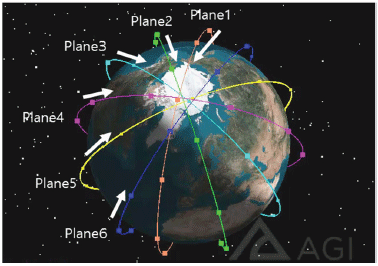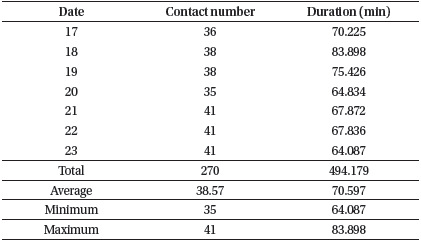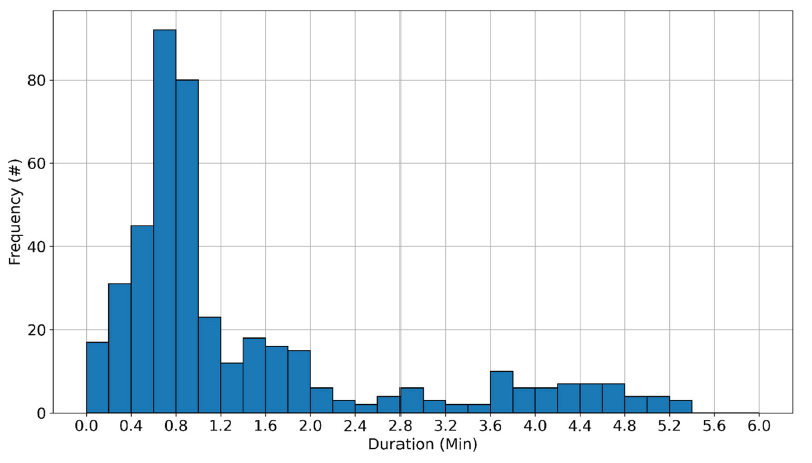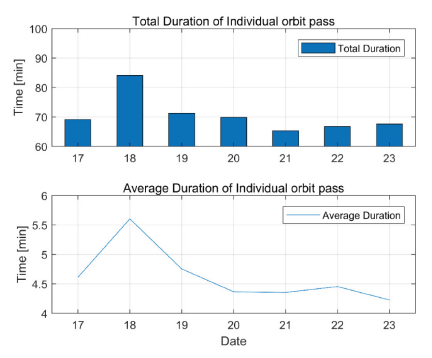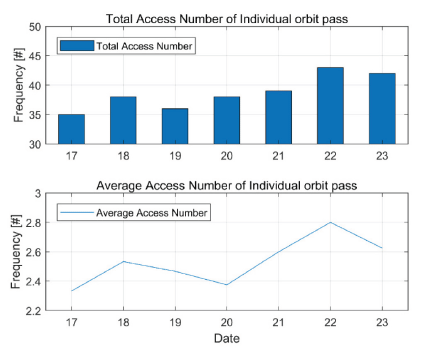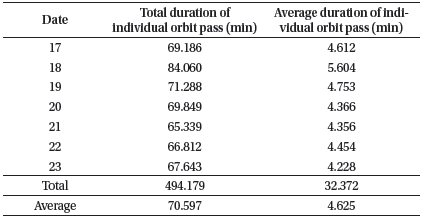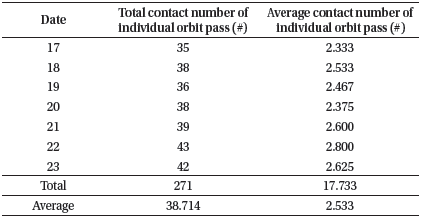1. INTRODUCTION
The small scale magnetospheric and ionospheric plasma experiment (SNIPE) mission, developed by Korea Astronomy and Space Science Institute (KASI) in 2017, is scheduled to be launched in 2023 (Lee et al. 2022). SNIPE is a space science mission used to temporarily and spatially investigate space environment phenomena for space weather research: electron microbursts, plasma trough, polar cap patches, equatorial plasma bubbles/blobs, Field-aligned currents, and electromagnetic ion cyclotron waves (Lee et al. 2022). SNIPE operates with four 6U CubeSats (KASISat-1), and its altitude is 500 km in a Sun-synchronous orbit (Kim et al. 2022). The distance of each KASISat-1 will be 10–100 km and will be maintained by a formation flying algorithm with a propulsion system (Kang et al. 2020;Song et al. 2021b). Scientific payloads of KASISat-1 are Solid State Telescope, Magnetometer (MAG), and Langmuir Probe (LP). In addition, Gamma Ray burst Monitor (GRM) and Iridium & GPS Board (IGB) are on-board as sub-payloads (Sohn et al. 2018). In particular, IGB is equipped to demonstrate an inter-satellite communication system by transmitting data to the ground via an iridium satellite (Cho et al. 2022).
Before the SNIPE mission, there were efforts for communication between a CubeSat and Iridium network in the past. Khan (2008) studied communication between nano-satellite and Personal Communication Networks such as INMARSAT, Thuraya, Global star, and Iridium. In 2011, at the Air Force Institute of Technology, researchers suggested a 3U-sized CubeSat named Persistent TT&C using LEO Satcom. The CubeSat had an Iridium 9602 modem to check the performance for near real-time communications (Rodriguez et al. 2016). On April 21, 2013, National Aeronautics and Space Administration (NASA) launched the Bell 1U PhoneSat based on the Google Nexus One smartphone with an Iridium transceiver. The goal is that the PhoneSat sends packets to the Iridium satellites, and the ground user receives the data from the Iridium satellites (Allmen & Perto 2014). Moreover, the Technology Education Satellite (TechEdSat-2) was developed in cooperation with NASA Ames Research Center and the University of Idaho and launched in 2012. It had the Iridium and Orbcomm modem, but the communication mission was unsuccessful (Rodriguez et al. 2016). Likewise, TechEdSat-4 had a main mission to demonstrate a de-orbit technology, and the submission was to communicate with the Iridium satellites to receive the location and altitude data during an orbital reentry period. Eventually, it was successful for the deorbit sequence and the communication with the Iridium satellite (Kim & Kim 2022). MiniCarb CubeSat was launched in December 2019 and reported a statistical result about communication through the Iridium satellites (Riot et al. 2021).
Here, the KASISat-1 communication capabilities with the Iridium satellite network are evaluated to determine the IGB requirements. As with other payloads that perform numerous ground tests and in-orbit simulations before launch (Song et al. 2021a), we validate the feasibility of the IGB and the enhancement of communication capabilities. Hence, communication link simulations are performed to calculate the contact number and the duration, analyzed by the individual orbit path. While the coverage of Iridium satellite communication can cover all of the ground, the communication coverage becomes smaller at an altitude of 500 km, as shown in Figs. 1 and 2. As shown in Fig. 3(a), the Iridium antenna is designed to cover the entire ground. At an altitude higher than the ground, the height of the coverage cone decreases, as shown in Fig. 3(b), and the area of the circular area also decreases.
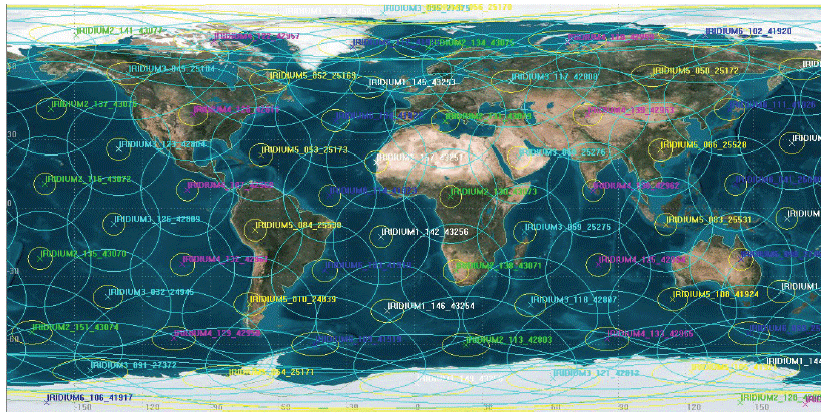
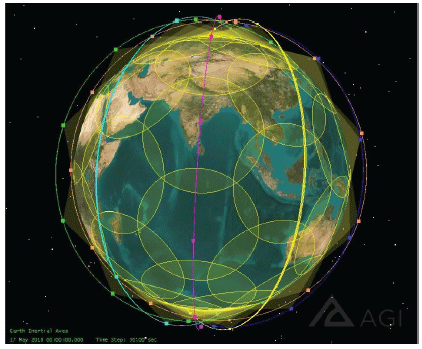
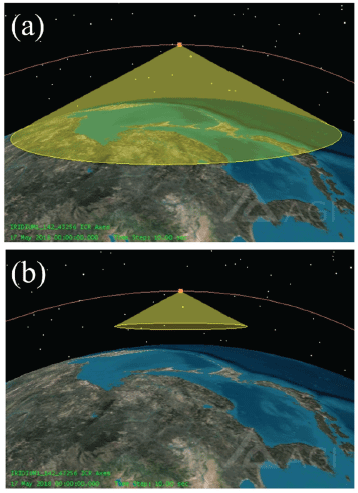
Furthermore, Iridium transceivers receive short messages regularly rather than continuously communicating throughout the communication time, so this paper focuses on the contact duration and numbers rather than speed. Therefore, when and how often KASISat-1 comes within coverage was investigated using Systems Tool Kit Pro (STK Pro Ver 11.2). KASISat-1 was also analyzed by altitude, which decreases due to atmospheric drag over its lifetime. Finally, the results are used in an optimal operation schedule while considering other scientific objectives and research.
2. INSTRUMENT
The Iridium and GPS Board (IGB) developed by Soletop (Daejeon, Korea) is one of the communication subsystems on KASISat-1. The IGB is a module that integrates the Iridium satellite communication function and GPS receive function. It is a 1U board of 10 × 10 cm, as shown in Fig. 4. IGB’s objectives are to demonstrate the Iridium communication technology in space and transmit the GRM data to the ground station through the Iridium satellite network.
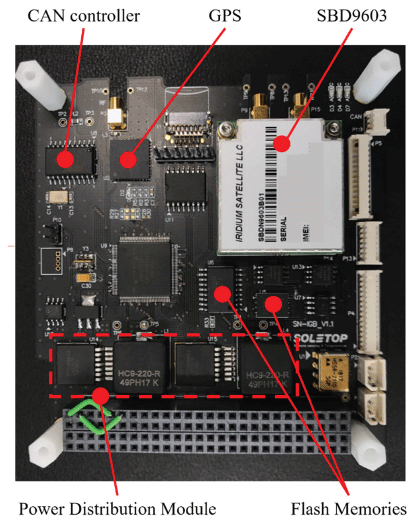
As the third communication subsystem after the ultra-high frequency (UHF) and S-band communication subsystem of the KASISat-1, the IGB uses Short Burst Data (SBD) service through the Iridium satellite constellation. Hence, it is suitable for transmitting State of Health data from a satellite or commands from a ground station rather than transmitting large scientific data. Thus, in an emergency mode where UHF and S-band communications are not possible, the IGB acts as an urgent communication medium by transmitting satellite status information over the SBD.
3. IRIDIUM SATELLITE CONSTELLATION
The Iridium satellite constellation is in a near-polar orbit at an altitude of 780 km. Therefore, one satellite revolves around the Earth in 94.74 min, with an orbital velocity of 7.524 km/s. As shown in Fig. 5, the Iridium satellite constellation comprises six orbit planes, expressed with different colors, and the velocity direction in each orbit is described by white arrows. There are 11 satellites in each of the 6 orbits; thus, 66 satellites are in operation. The six corotating orbital planes are 31.6° apart in the longitudinal direction (Maine et al. 1995). However, orbital planes 1 and 6 are counter-rotating in opposite directions, so only these two orbits are located 22° apart in longitude (Pratt et al. 1999). Some spare satellites are waiting for in-orbit, so when the operating satellite decay due to a critical error or an accident, a spare satellite can be placed immediately by orbit transfer (Brunt 1996;Fossa et al. 1998).
Communication between KASISat-1 and Iridium satellites uses the L-band (1,616.0–1,626.5 MHz) as the link band used by ordinary users. Through the SBD service, a text transmission service in the L-band, KASISat-1 exchanges data with ground stations through the Iridium network. Inter-Satellite Link (ISL) between Iridium satellites uses the 23.18–23.38 GHz band in the Ka-band, and communication between the Iridium satellite and the Iridium ground gateway uses 29.1–29.3 GHz as uplink and 19.4–19.6 GHz as downlink in the Ka-band [Buntchuh 2008].
To apply the Iridium Satellite Constellation in STK, the Two Line Element information of the Iridium satellites applies to the simulation during the scenario period. The Iridium number and Space Surveillance Catalog number for this simulation are listed in Table 1. These satellites do not change their orbits, so no Iridium satellite enters and decays the operational orbit in the simulation period.
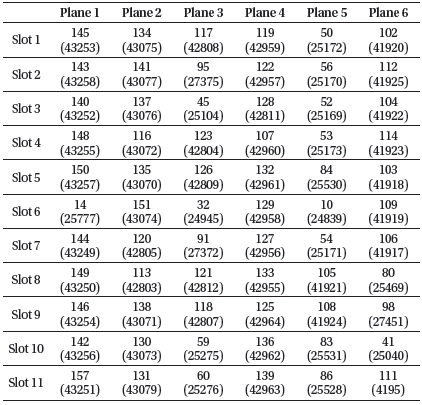
|
4. SIMULATION
The reference period of the simulation is from May 17, 2018, to May 25, 2018. This period is used to avoid the time to process replacement from Iridium to Iridium NEXT; therefore, Iridium satellites maintain a constant distance from each other for a week. The time unit is Universal Time Coordinated in Gregorian format (UTCG) in STK. However, instead of UTCG, LoCaL in Gregorian format (LCLG) is accepted to simply calculate and express the time. Therefore, the simulation period is a week starting from “May 17, 2018 00:00:00.000 LCLG” to “May 24, 2018 00:00:00.000 LCLG” in South Korea.
All antennas of Iridium satellites are represented using sensor objects “cone half angle” applied as the unit to represent the conical angle (Claybrook 2013), which is the same as the half of Field of View. The antenna location is set in the center of the Iridium satellite body and points to the center of the Earth at all times, making a similar coverage of the simulation as in reality. Likewise, the IGB antenna of the KASISat-1 is assumed to have 60° of cone half angle as the simple conic type of sensor object, located in the center of the KASISat-1 body, and pointing toward the zenith.
Although four of KASISat-1 will operate in formation flying, only one of KASISat-1 is considered to operate with a default Sun-synchronous orbit at an altitude of 500 km in this STK simulation. The attitude of the KASISat-1 is set by the “Aligned and Constrained type.” The −Z-axis of the KASISat-1 body frame is aligned with the direction of the zenith vector during the simulation period. The +X-axis is constrained by the angular momentum of the orbits. Hence, the +X-axis is perpendicular to the orbital plane. This setting allows KASISat-1 to keep its attitude in the normal mode in STK. Although the actual KASISat-1 antenna pattern is hemispherical, the conical half-angle is set to 60° in the simulation. Even in limited situations where the antenna always looks at the ceiling, this margin reduces the antenna’s directional error.
To perform the simulation as best as possible, there are constraints for simulation similar to real. One is that the Doppler shift range is 70.2 kHz, and the causing range rate is 13 km/s. This means that the Doppler shift is 1.56% of the bandwidth for the center frequency of 1,620 MHz on the Iridium L-band user link, so it is enough to set the maximum range rates as 13 km/s on all sensor objects (Claybrook 2013). The second constraint is to be within 4,000 km of the transfer range. Because in the simulation, the range of communication was less than the radius of the Earth to prevent the error of communicating through the Iridium satellite on the other side of the Earth. The last constraint is that this simulation considers the duration longer than 10 s because the initial time to build the link is at least 10 s. Therefore, it is assumed that the initial time required to generate communication is 10 s, and communication is impossible during this time.
5. RESULT
The contact number means to count the contact frequency, and the duration is the communication period, which is the time taken from the start to the end of the transmission. For each date, the contact number, duration, and statistical elements: total, average, minimum and maximum values are shown in Table 2. On average, the contact number is approximately 38.57 times a day, and the duration is 70.597 min daily.
Moreover, every duration is organized by occurrence frequency and expressed by the histogram in Fig. 6. The x-axis means the duration. The duration between 0.6 and 0.8 is 92 times, and the duration between 0.8 and 1 min is 80. For a 1-min duration, 17 contacts are included. So, half of all contacts is less than 1 min. The duration of more than two min is less than ten times and seldom occurs because KASISat-1 rarely passes through the center of the Iridium satellite’s coverage and mostly through the edge of the coverage.
Based on the previous analyses, statistics for the total and average duration are compiled in Table 3 and Fig. 7. Total duration is a summation of duration for each orbit pass of each date. For example, the total duration of May 17 is the sum of the duration of individual orbit pass on May 17. Likewise, average duration is the average time of individual orbit pass on each date. Therefore, according to the total duration result, on average, Iridium satellite communication is maintained for 70.597 min daily. Moreover, 4.625 min is the average duration of an individual orbit pass. As the orbit period is 94.74 min, 4.625 min of average duration is approximately 5% of one orbit period. In addition, the average contact number is 38.714 times daily, and the total contact number for seven days is 271 times. Moreover, the orbit average of the contact number is 2.533 times in Table 4 and Fig. 8.
Fig. 9 shows where the altitude decreases with satellite life and falls from 500 km to 250 km every 50 km. The x-axis of each panel is displayed by date for a week. The top panel is the average time per contact, the middle panel is the total duration, and the bottom panel is the number of communications. The lower the altitude, the greater the opportunity to enter the antenna coverage of the Iridium satellite, so the contact number and duration are increased. As the simulation time is only one week, there is a deviation by date because the latitude of the Iridium orbit plane and the orbit plane of KASISat-1 always changes little by little. Nevertheless, the Iridium satellite group operates at regular intervals, so unless there is a fatal change in the position of the satellites, the deviation by date is not expected to increase.
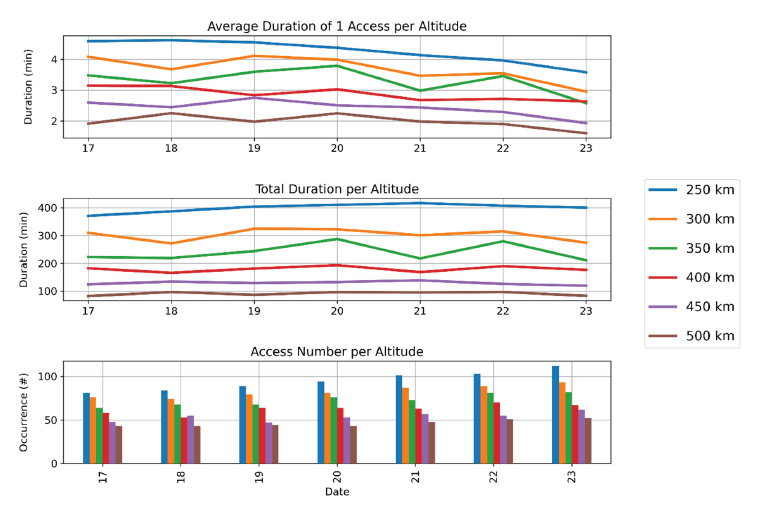
6. CONCLUSION
SNIPE is a mission to observe the space environment with the formation flying of four KASISat-1 on a Sunsynchronous polar orbit at an altitude of 500–600 km. Each KASISat-1 had three scientific instruments: the LP measuring the density of cold ionospheric electrons (Song et al. 2022), the Solid-State Telescope measuring energetic electron flux (Sohn et al. 2018), and the 3-axis fluxgate MAG measuring magnetic field vectors (Song et al. 2021a). In particular, IGB communicating with Iridium satellites was mounted for technical demonstration.
To find out when and how often Iridium communication is linked via IGB, communication analysis with Iridium satellites was performed using STK. This study focused on the contact number and duration of the individual orbit pass. These parameters were essential to estimate the amount of transmitted data size when the data rate is known. The 7-day simulation was performed to calculate the contact number and duration. Several constraints were considered such as the attitude of the KASISat-1, communication frequency band by Doppler shift, communication range, and minimum duration.
Based on the simulation result, the individual orbit period was calculated first and gave a consecutive number to each orbit pass. Every individual orbit period was 94.74 min; the KASISat-1 could rotate the earth 15 or 16 times daily. To find the average duration per individual orbit pass, all communication durations were matched into individual orbit periods, then statistics for the duration were collected according to individual orbit. As a result, the KASISat-1 could communicate with the Iridium satellite for 4.625 min per contact on average, linked to the ground station at least once an orbit, and the total duration per orbit was 70.597 min on average. About the contact number per orbit, the average daily contact number was 38.714 times, and the average contact number per orbit was 2.533 times. In addition, the range between 0.5 and 1.5 min duration accounts for 57.03% of the total contacts number for a week.
Regarding SBD communication speeds in the L-band, Dahal (2002) and Riot (2021) reported 50 kbps, and Corpino (2022) mentioned 64 kbps. Iridium SBD communication speed is not officially well known because it does not continue to be connected to the Iridium satellite. Still, it sends and receives short text within hundreds of Kbytes. In addition, it takes several seconds at the earliest to send the message and several minutes at the slowest. Due to this uncertainty, it is more appropriate to collect and send satellite internal commands than to send scientific mission data that requires knowledge of the daily transmission. Nevertheless, to calculate the daily data transmission, assuming that the speed is 50 kbps and the communication is 70 min daily, it is 210,000 kbps, which is about 100,000 SBD messages of 200 bytes.
Therefore, these results are crucial for in planning an operation schedule for KASISat-1 and beneficial in estimating the power consumption for adjusting the power budget. This study will be valuable for future research on advanced ISL technology.
